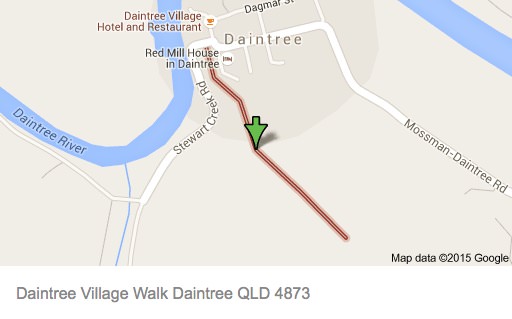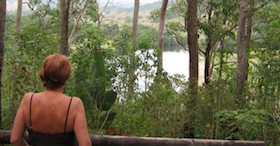Starts from Pioneers
Park.
Walk 50 metres along Stewart Creek Road and take the first track to
the left, on the edge of Pioneers Park. Go past the water treatment
plant and water tanks. As hiking trails go it starts off steep but
gives good views of the Daintree Village and the Daintree River.
"THE FOREST ALONG THE RIDGE OVERLOOKING THE RIVER AND THE DAINTREE
VILLAGE is described as being in a successional stage. It is a
forest undergoing changes in its specie types as one specie prepares the
way for and is replaced by others until a stable state is reached.
It can be guessed that this hillside was exposed to occasional cyclonic
winds and frequent fires over many centuries, until quite recently when
only two small fires have been seen in 20 years, one in 2003.
Under such conditions the vegetation will have been an open woodland
dominated by eucalypt (gum) trees with wattles (acacias) and sheoak
(Allocasuarinas ) as sub canopy trees above an under story of Kangaroo
Grass (Themeda triandra) and Bladey Grass (Imperata cylindrical ).
In places of high rainfall such as the Daintree region a reduction in
the frequency of fires allows several species of rainforest trees to
arrive as "pioneers" which begin to colonise the understory. If
freedom from fire and big blows persist for a few decades the plants of
the understory will produce enough shade and damp to prevent eucalypt
seeds and seeds of most other open forest species from producing healthy
seedlings. In time the eucalypts and most of the wattle species
will die out and be succeeded by a good range of rainforest
species. This is the derivation of the term "successional stage".
At present the tallest trees along the route are eucalypts, most
belonging to a species known as the Large Fruited Stringybark or Red
Stringybark (Eucalyptus pellita).
The Pink Bloodwood (Eucalyptus intermedia ) and Moreton Bay Ash
(Eucalyptus tesseiaris) can also be seen on route.

Daintree Village Natural Walk

Lookout over the Daintree River.
Other members of the forest community which can be seen along the route are the Paperbark Mahogony (Tristaniopsis suaveolens) and amongst smaller trees the Cocky-apple (Planchonia careya).
An interesting tree which occupies an intermediate position between open forest and rainforest is the Golden Bouquet Tree (Deplanchea tetraphylla) which carries its leaves in whorls of four and produces clusters of bright yellow flowers. The seeds are wind driven.
Most of the pioneer plants are dependent on wind to drive their seeds or put out lots of small fleshy fruit which are attractive to birds. A very common example of plants with wind driven seeds along this route is the "Milky Bean" or (Ristonia muelleriana).
Also common among the pioneers on this route is the Brown Kurrajong (Commersonia bartramia). It produces small seeds each of which carries a bird attracting tissue called an aril which induces birds to carry the seed about.
Pioneers with a bird enticing fleshy fruit include a tree often referred to as the Ivory Bass Wood, (Polyscias australianum) and a related and decorative specie Celery Wood or Polyscias elegans. (Polyscias describes the arrangement of flowers, which are arranged on stems somewhat like an umbrella).
"Look out for Lovely Fairy-wrens in family groups by the track"